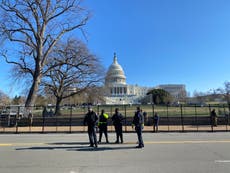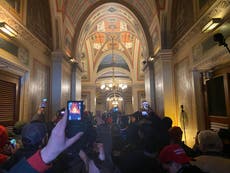‘Storm the Capitol’: Violence organised on social media as warnings of far-right post-election went unheard
Federal law enforcement has warned for years about far-right threats. Trump supporters openly planned armed insurrection for weeks, writes Alex Woodward


Federal law enforcement agencies have sounded alarms about the rising threats of far-right violence and white nationalists for months, across internal warnings, in-depth reports and congressional testimony.
But in the days before a violent mob breached the US Capitol and stormed the halls of Congress, law enforcement appeared to abandon those warning signs and ignore the mass organising on social media, where a constellation of far-right Americans announced plans to “storm the Capitol” and carry out Donald Trump’s demands to overturn the results of the presidential election.
The event marked a convergence of Trump supporters, from MAGA personalities and QAnon cultists to members of nationalist groups like the Proud Boys. They posted about 6 January on pro-Trump message board The Donald and QAnon-hosting 8Kun, as well as right-wing platforms and messaging apps like Parler, Gab and Telegram.
But the organising and discussion was not limited to darker or more-obscure corners of the internet, but on mainstream platforms like Facebook groups and on Instagram stories, Reddit, TikTok, Twitter and YouTube.
Rioters discussed and debated plans for weeks leading up to the day a joint session of Congress formally convened to count the Electoral College votes, with vice president Mike Pence presiding, as a growing caucus of Republican lawmakers announced plans to support the president’s false allegations of widespread voter fraud and claims that the election was “stolen” from his supporters.
At least five people have died, including a woman who was shot by Capitol police, three people who died from medical emergencies, and a Capitol police officer who died in hospital after a rioter struck him in the head with a fire extinguisher. Police discovered pipe bombs and a cooler full of molotov cocktails in the aftermath.
In September, the FBI issued an intelligence report warning that far-right groups and white supremacists pose a “violent extremist threat” to the US, specifically within a time period between Election day and the 2021 presidential inauguration that could serve as a “potential flashpoint” for violence.
A 2020 report from the Department of Homeland Security warned that domestic violent extremist groups remain the nation’s largest security threat.
“White supremacist violent extremists who have been exceptionally lethal in their abhorrent, targeted attacks in recent years,” Acting DHS Secretary Chad Wolf wrote in the report.
The agency reported that a “new, alarming trend of exploitation of lawful protests causing violence, death, and destruction in American communities” has erupted in recent months, during Black Lives Matter protests across the US, which were compromised by “the co-opting of lawful protests” that “led to destruction of government property and have turned deadly.”
But FBI and DHS officials did not produce a threat assessment ahead of the violence on 6 January, according to The Wall Street Journal. A security advisory shared among federal, state and local agencies would typically brief law enforcement about notable events and potential vulnerabilities; that was never produced, according to reports.
A spokesperson for the FBI declined to comment to The Independent.
DHS spokesperson Chase Jennings told The Independent that DHS set up a virtual situation room on 5 January and received a call for support from US Capitol Police at 2.30pm on 6 January. Attacks on the Capitol started at roughly the same time. “DHS had open channels with partners and shared information on those channels as necessary,” he said in a statement.
Washington DC’s Metropolitan Police Department chief Robert Contee said on Thursday that there was “no intelligence that there would be a breach” at the Capitol.
But reports from online research groups, journalists and civil rights organisations found a flood of threats and calls for violence on 6 January weeks ahead of the failed insurrection.
A widely shared image promoting “Operation Occupy the Capitol” was posted to a pro-Trump Facebook group late last year and shared across Twitter and 8chan.
The day before the siege, a user on 8chan said to gather “as many Patriots as can be.”
“We will storm the government buildings, kill cops, kill security guards, kill federal employees and agents, and demand a recount,” they said.
Another poster asked what they should do if Congress “ignored the evidence” of voter fraud.
“Storm the Capitol,” another person replied.
Users on the pro-Trump forum The Donald encouraged armed supporters to move “en masse.” Others admitted they prepared to tell their families goodbye.
“Something has turned in me and I can’t go back,” one woman said.
Research group Advance Democracy found that posts with calls for violence on the website had more than 120,000 engagements as of Wednesday.
Posts collected by disinformation-focussed nonprofit organisation Network Contagion Research Institute and online investigations website Bellingcat uncovered dozens of similar insurrection-inspired calls to action, invoking violent language and civil war in the days leading up to 6 January.
“In recent weeks, extremists repeatedly stated their desire for chaos and destruction at January 6 protests in Washington,” said Jared Holt with the Atlantic Council’s Digital Forensic Research Lab. “Several communities monitored by DFRLab discussed the use of overwhelming crowds to violate laws and enter the Capitol.”
The reliance on disinformation created and amplified by the president played a critical role in the escalating talks of violence, according to the group.
Violence was “born out of a detachment from the shared set of facts that democracy depends on,” said DFR director Graham Bookie.
Moments after the president condemned Mike Pence because he didn’t “have the courage to do what should have been done” and overturn votes from millions of Americans, based on debunked conspiracies and baseless claims of voter fraud, his supporters broke into the Senate chambers and demanded to see the vice president.
Far-right personalities Nick Fuentes and Tim “Baked Alaska” Gionet streamed themselves ransacking the Capitol. On his livestream, Gionet attacked “globalists” and shouted “America first” and “trust the plan”, a QAnon rallying cry.
Pro-Trump QAnon figure Jake Angeli, known as the Q Shaman, was widely photographed inside.
Hundreds of people had travelled across the US to participate, uploading content across all their social networks, collected and spread even further on mainstream channels and on global news sites, generating massive traffic and engaging in real-time the same groups of far-right supporters who encouraged the attack.
Attempts to label or otherwise censor fast-flowing content, like Twitter’s decision to remove the president’s posts encouraging his supporters, “is of least effectiveness in fast-moving situations like the riots of January 6, in which the mere existence of Trump’s messages had the effect of pouring gasoline on a fire,” DFR fellow Emerson Booking said.
In the aftermath of the insurrection, pro-Trump online communities are adrfit – confused that the president did not introduce the damning evidence of election fraud that would defend their crusade, outraged that he has now sought to punish rioters after encouraging them to march to the Capitol steps, and emboldened to strike back following the deaths of at least three rioters. Others believe the president has been compromised by the “deep state” they believe he had fought against. A widely photographed scrawl of “murder the media” inside the Capitol has now become a rallying cry.
During his speech to supporters before the attack, a user on The Donald forum said: “I thought this was the rubicon speech but he's talking about campaign s*** still? … I thought he was going to show us evidence not talk about Oprah wtf.”
On Thursday night, after telling his supporters he loved them as they ripped up the Capitol, the president condemned the “heinous attack” and said he was “outraged by the violence, lawlessness and mayhem.”
He said that the rioters “who infiltrated the Capitol have defiled the seat of American democracy."
The president has been accused of ignoring warnings while emboldening violent groups that have promised them loyalty. During the first presidential debate in September, when asked to flatly condemn white supremacy, the president equivocated and asked for a specific name.
He said: “Proud Boys, stand back and stand by, but I’ll tell you what somebody’s got to do something about antifa and the left because this is not a right-wing problem. This is a left-wing problem.”
The president has been accused of ignoring calls from his own administration to confront right-wing violence while relying on his Justice Department to prosecute his political enemies.
Enrique Tarrio, the Proud Boys “chairman” who was arrested by DC police on Monday after admitting to destroying a Black Lives Matter banner at a historic Black church during a separate riot in Washington last month, also is facing felony charges for possessing two high-capacity firearm magazines, bearing gold Proud Boys insignia, during his arrest.
Ahead of the riots, he said his male-only fascist group would “be incognito and we will spread across downtown DC in smaller teams.” Afterwards, he urged his followers on Parler to migrate to encrypted apps and messaging services to evade law enforcement.
On Parler, Proud Boys founder Gavin McInnes denied the group’s involvement in the riots and suggested antifa led the attack. The antifa allegations spread immediately among pro-Trump communities; Republican Congressman Matt Gaetz was booed by his colleagues on the House floor on Wednesday night after he falsely accused antifa of responsibility for the attacks.
Days earlier, the White House issued a memo in a last-ditch attempt to link antifascists to terrorism by instructing the Secretary of State to include antifascist organisers among “aliens who are members of an identified criminal organization” within the country’s Foreign Affairs Manual.
In a statement announcing the memo, White House press secretary Kayleigh McEnany said: “This violence and lawlessness has no place in the United States and will be called out for the domestic terrorism that it is.”
Inside the Capitol, rioters carried Confederate symbols and wore Nazi imagery as they ransacked the building, unmoved by law enforcement, in stark contrast to the overwhelming police and federal response to Black Lives Matter protests across the US.
In February 2020, FBI director Christopher Wray told the House Judiciary Committee that the threat of far-right domestic violent extremism has risen to a "national threat priority,” posing a "steady threat of violence and economic harm" as long as its underlying drivers persist, including "perceptions of government or law enforcement overreach, socio-political conditions, racism, antisemitism, Islamophobia, and reactions to legislative actions.”
In 2019, the FBI reported 107 domestic terrorism arrests, on pace with the number of arrests it made for international terrorism. Racism and hate-driven ideologies were the driving forces behind most of the ideologically motivated killings and violence in the US in 2018 and 2019, and were the most lethal of all domestic extremism movements over the last 20 years.
Mr Wray said: "The spate of attacks we saw in 2019 underscore the continued threat posed by domestic violent extremists and perpetrators of hate crimes. Such crimes are not limited to the United States and, with the aid of Internet like-minded hate groups, can reach across borders."
DHS officials began addressing white supremacist violence in 2019, when then-acting secretary Kevin McAleenan described white nationalism as one of the most dangerous threat to the US as he delivered “direct and unambiguous” remarks stressing that the “continuation of racially based violent extremism, particularly violent white supremacy, is an abhorrent affront to the nation.”
In 2017, the FBI and DHS had warned in a joint intelligence report titled “White Supremacist Extremism Poses Persistent Threat of Lethal Violence” that “lone actors and small cells” within the “white supremacist extremist movement” will continue to pose a violent threat to the US over the course of the following year, claims that have echoed in subsequent reports.


Join our commenting forum
Join thought-provoking conversations, follow other Independent readers and see their replies
Comments